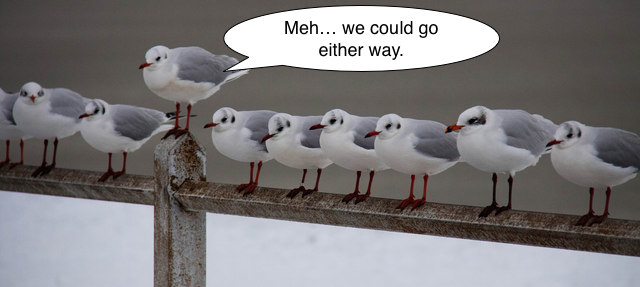What is a persuasive essay?
In the simplest of terms, a persuasive essay is intended to persuade. It should incite action and pull readers toward a given point of view, or convince those whose minds are not yet made up.
The targets of a persuasive essay are those who are “on the fence.”

If someone is already inclined to agree with you, you don’t need to write an essay to convince him. If someone disagrees with you, it’s not likely your essay will get him to change his mind (unless you’re an awesome writer).
If you are writing an academic persuasive essay, your strategy should be to assume a “disinterested” or neutral audience. (Note, this is not the same thing as “uninterested.”) Your readers need convincing but not, as it were, at gunpoint. It is usually enough to craft a good, persuasive, and well-structured argument.
At the very least, your readers should acknowledge that your argument is valid—this is your minimum goal (“Hmmm, he could be right”).
One of the most famous persuasive essays is Thomas Paine’s “Common Sense,” widely acknowledged to have played a major part in inciting the American Revolution. He targeted the fence-sitters. Even after the war started, only 1/3 of the colonists actively supported the Revolution, so persuading people to join the side of the rebels was vital.
What Makes for a Particularly Good Persuasive Essay?
The very best persuasive essay completely ignores any reasons the author may have to hold or adopt a given point of view and instead focuses on why the audience may want to adopt it. The best persuaders always have this in mind.
Say you’re trying to convince your boyfriend to take you to the movies (not by writing an essay, but bear with me), and you really want to see this wonderful chick-flick romantic comedy.
You’re not likely to make any headway with him by saying that the movie explores the joys and depths of human relationships. Instead, just tell him that the female lead is is really hot. Or tell him that despite the trailer, the movie has lots of car chases and explosions.

If you get my drift, the best persuasive essay isn’t so much about objective truth as it is about getting into your audience’s heads.
On the flip side of the coin, you can craft an argument of soaring, irresistible logic, but if you don’t tailor it to your audience, it’ll fizzle.
What Makes for a Particularly Bad Persuasive Essay?
The worst kind of persuasive essay is “Why I think we all should blah blah.” From the point of view of the reader, what the author thinks means less than nothing.
This might seem obvious, and indeed most awful essays aren’t that crude in their approach. What they do is parrot some creed/ideology/religion/political party and use that as an avatar for the author.
It doesn’t enhance a person’s argument in the slightest to substitute “the Bible/the Party/the Grand Order of Caribou tells us…” for “I think…” If the target audience doesn’t subscribe to the ideology of the speaker, then appeals to that ideology are futile.
What makes a good and a bad persuasive essay, then, are opposite characteristics: complete attention to the audience’s receptiveness, or ignoring it completely.
Many terrible writers and speakers mask their awfulness by “preaching to the choir.” They only address those who are massively inclined to agree with them in the first place.
A common example of this is speeches given at political party conventions. These politicians have audiences of tens of millions of individuals, but they don’t convince a single person of anything.
What Are Three Simple Steps that a Writer Can Take to Write a Better Persuasive Essay?
1. Call to action. The first thing you have to do is clearly state what it is you want to persuade your audience to do: Vote for Joe Shlabotnik, switch to fluorescent lighting in the home, ban walrus hunting, eat more fiber. Whatever it is, you need to start off by a call to action (or thought).
2. Reasons for acting. The second step is to give your audience some reasons why they should do this. Note that these reasons can easily be “reasons.” in other words, they don’t have to be logically supportable.
As I keep saying, appeal is all you need. That said, if you are working in the context of formal writing, such as academics or business, your reasons should make sense (“Given that we are in a business environment where internet connectivity is paramount, we should replace our carrier pigeon flock with high-speed computers”).
3. Benefits of acting. The third step should logically flow from the second. What are the potential benefits? What does the audience (not you) stand to gain from taking this action/changing this thinking/adopting this strategy? Sell the concept!
In other words:
- We should do blah blah.
- Because it would be the right and just thing to do.
- And beer will flow freely down the streets of America.
For more information on writing awesome persuasive essays, check out How to Create a Persuasive Essay Outline.
Good luck!